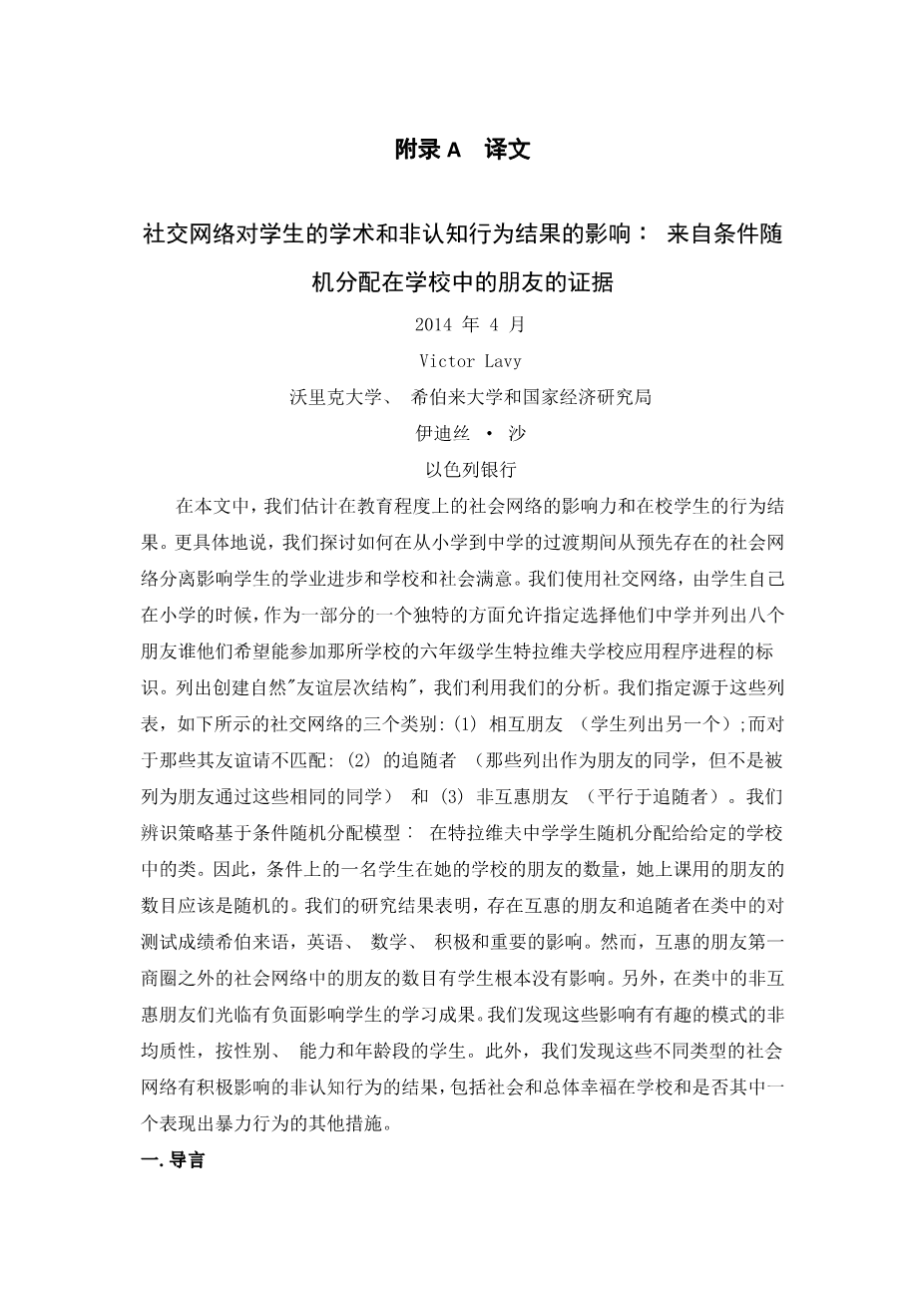社交网络对学生的学术和非认知行为结果的影响︰来自条件随 机分配在学校中的朋友的证据外文翻译资料
2022-08-12 16:49:36
The Effect of Social Networks on Studentrsquo;s Academic and Non-Cognitive Behavioral Outcomes: Evidence from Conditional Random Assignment of Friends in School
April 2014
Victor Lavy
University of Warwick, Hebrew University, and NBER
Edith Sand
Bank of Israel
In this paper, we estimate the influence of social networks on educational attainment and behavioral outcomes of students in school. More specifically, we investigate how separating from pre-existing social networks during the transition from elementary to middle school affect students academic progress and school and social satisfaction. We use social networks identified by the students themselves in elementary school, as part of a unique aspect of the Tel Aviv school application process which allows sixth-grade students to designate their middle schools of choice and to list up to eight friends with whom they wish to attend that school. The lists create natural “friendship hierarchies” that we exploit in our analysis. We designate the three categories of social networks that stem from these lists as follows: (1) reciprocal friends (students who list one another); and for those whose friendship requests did not match: (2) followers (those who listed fellow students as friends but were not listed as friends by these same fellow students) and (3) non-reciprocal friends (parallel to followers). Our identification strategy is based on a conditional random assignment model: in Tel Aviv middle schools studentsrsquo; are randomly assigned to classes within a given school. Therefore, conditional on the number of friends a student has at her school, the number of friends she attends class with should be random. Our results suggest that the presence of reciprocal friends and followers in class has a positive and significant effect on test scores in English, math, and Hebrew. However, the number of friends in the social network beyond the first circle of reciprocal friends has no effect at all on students. In addition, the presence of non-reciprocal friends in class has a negative effect on a studentrsquo;s learning outcomes. We find that these effects have interesting patterns of heterogeneity by gender, ability and age of students. In addition, we find that these various types of social networks have positive effects on other measures of non-cognitive behavioral outcomes, including social and overall happiness in school and whether one exhibits violent behavior.
I. Introduction
There are many educational programs and practices that separate students from their social network in school or class. For example, school busing programs and policies that enhance school choice in order to increase school productivity (by introducing competition among schools) often detach students from their childhood social network.1 Other policies that often lead to students being separated from their friends include educational reforms that redesign school zones or catchment areas, programs which expand student access to high-performing schools, or reassigning students when they advance to a higher grade in primary school.2 Social and welfare programs, such as the US Moving to Opportunity, also detach though voluntarily children from their childhood social environment.3 The consequences of such social detachment are usually not taken into account in policy making circles4, even though it is well documented in the sociology and psychology literature that students social networks are important for their academic performances and overall development (Wentzel 1993, Roseth et al. 2008).5
In this paper we investigate the influence of social networks on educational attainment and non-cognitive behavioral outcomes of children in school while carefully addressing the identification and the causal nature of the relationship. Our unique contribution is the analysis of impact of various social networks, while examining as well the narrow and wider circles of these social environments.We base our analysis on a school choice program that started in Tel- Aviv in 1994 which allowed students who completed primary school to choose their middle school.
6 While much of the literature on school choice compares the benefits that accrue to students who receive their first school choice relative to students who did not, this paper highlights another important and generally overlooked angle of this process: the importance of maintaining ones social network throughout middle school.7 Our evidence suggests that taking into account the students social network can create a better assignment of students among and within schools in general and improve the design of school choice programs in particular.
For our research, we take advantage of a unique dataset from a Tel Aviv school choice program that allows us to analyze the studentsrsquo; social networks in elementary schools. These networks are identified by the students themselves as the result of an unusual aspect of the Tel Aviv school application process, which allows sixth-grade students to designate their middle schools of choice and to list up to eight friends with whom they wish to attend that school. The lists create natural “friendship hierarchies” that we exploit in our analysis. We designate the three categories of requited and unrequited networks of friends that stem from these lists as follows: reciprocal friends (students who list one another), and for those whose friendship requests did not match: followers (those who listed fellow students as friends but were not listed as friends by these same fellow students) and non-reciprocal friends (those who were listed by fellow students but did not reciprocate by putting the same students on their own lists).
Using these data, we examine the consequences of the school transition on the size of a studentrsquo;s
剩余内容已隐藏,支付完成后下载完整资料


英语译文共 10 页,剩余内容已隐藏,支付完成后下载完整资料
资料编号:[484683],资料为PDF文档或Word文档,PDF文档可免费转换为Word
课题毕业论文、开题报告、任务书、外文翻译、程序设计、图纸设计等资料可联系客服协助查找。



